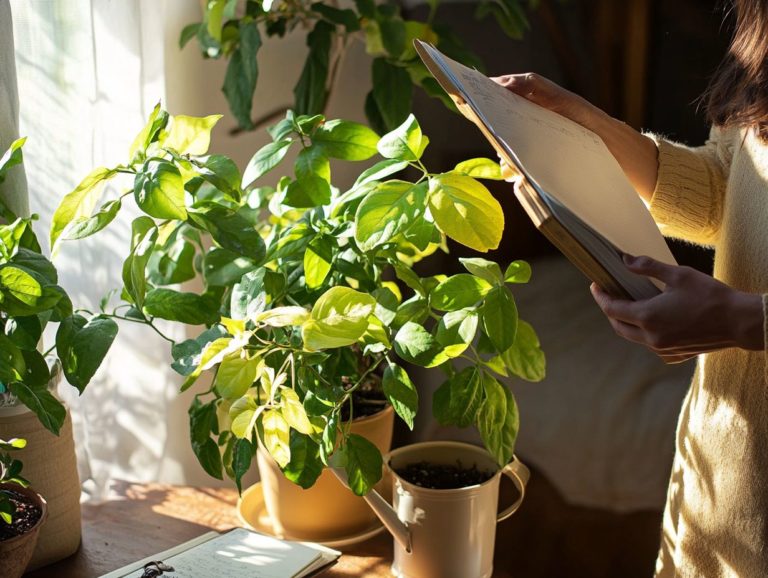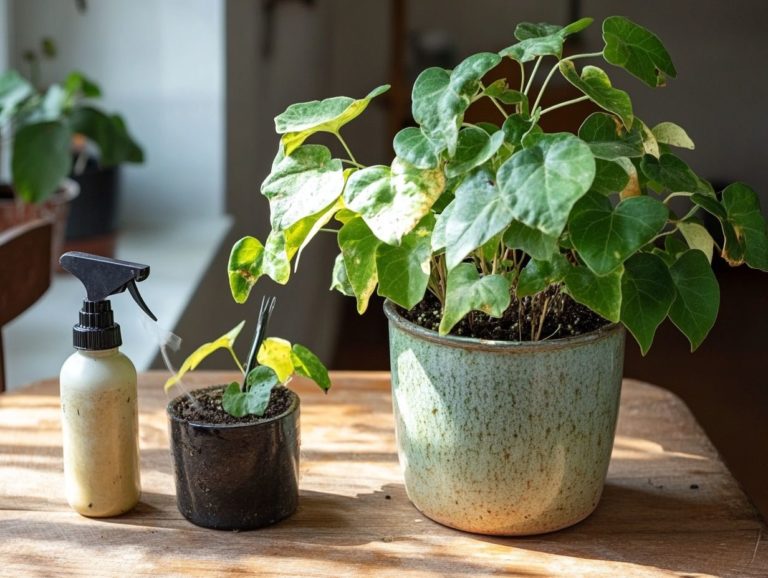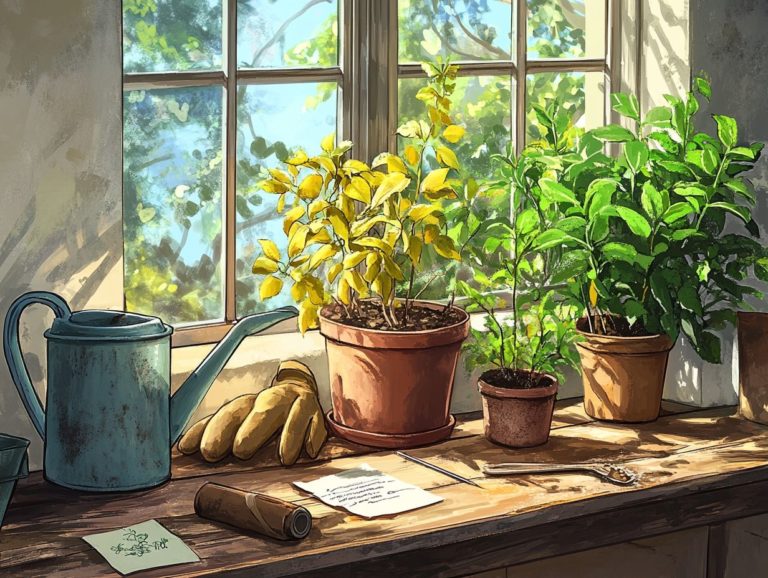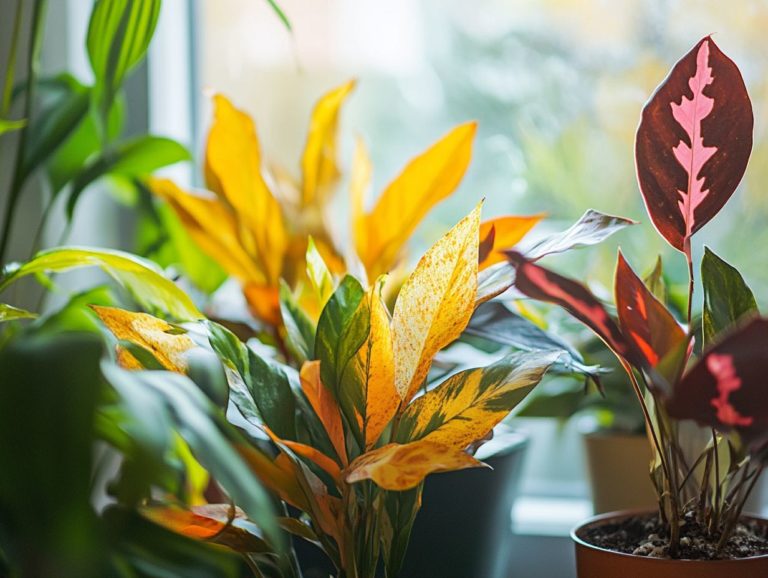Common Problems with Pothos Plants
Pothos plants are not just beautiful; they are your ticket to a vibrant home! But watch out for common challenges that could dim their shine. Cherished houseplants, they are celebrated for their vibrant, trailing vines and remarkably low maintenance needs. However, even these resilient beauties can face a few common challenges that might leave them looking a bit underwhelming.
From yellowing leaves to pesky insects and root rot, recognizing these issues is key to reviving and maintaining your pothos. This article delves into these problems, providing practical solutions and insightful tips to ensure your plant flourishes for years to come.
Contents
Key Takeaways:

- Yellowing leaves are a common problem with Pothos plants and can be caused by overwatering or lack of nutrients.
- Pests and diseases can also affect Pothos plants, such as mealybugs and fungal infections.
- Root rot is a serious condition that can quickly kill a Pothos plant and can be prevented by proper watering and drainage.
What are Pothos Plants?
Pothos plants, scientifically called Epipremnum aureum, are the quintessential houseplants you ve been looking for. Belonging to the Araceae family, they are adored for their lush, trailing vines and effortless care.
Known as Golden Pothos or Devil s Ivy, these plants thrive in a variety of indoor conditions, making them the perfect choice whether you re just starting out or are already a seasoned plant enthusiast.
With stunning varieties like Marble Queen, Pearl Jade, and Silver Splash, Pothos can elevate any space with their vibrant green foliage and unique patterns. Originating from the tropical rainforests of the Solomon Islands and the South Pacific, Pothos plants have seamlessly adapted to indoor life, bolstering their reputation as resilient houseplants.
Their impressive ability to purify indoor air by filtering out toxins adds to their allure, promoting a healthier living environment. They thrive in a range of lighting conditions, from cozy low light to bright indirect sunlight, allowing you to place them almost anywhere whether in a snug corner or a sunlit office space.
This versatility, coupled with their striking appearance, makes them a favorite among indoor gardeners eager to effortlessly beautify their homes.
Common Problems with Pothos Plants
Despite their remarkable resilience, Pothos plants can still face a range of common challenges that may impede growth. You might notice yellowing leaves, curling foliage, or brown spots.
These issues typically stem from factors like overwatering, underwatering, or pest infestations. All of which can lead to serious diseases and compromise the overall health of your cherished indoor plants.
Yellowing Leaves
Yellowing leaves are one of the most telling signs that your Pothos plant is in distress. This condition often stems from factors such as overwatering, which can lead to root rot, or underwatering, where your plant simply isn’t receiving enough moisture.
Nutrient imbalances can also contribute to this dilemma. It s essential for you to identify the root cause for timely intervention.
To effectively assess moisture levels, feel the top inch of the soil; if it feels dry, it’s time for a thorough watering. On the other hand, consistently damp soil might indicate overwatering.
Adjusting your watering schedule based on the season and humidity can significantly enhance your plant’s well-being. Selecting a suitable potting mix that encourages good drainage and aeration is also crucial in preventing complications.
Incorporating a balanced houseplant fertilizer is essential, as nutrient-rich soil fosters vibrant foliage and effectively combats those pesky yellowing leaves.
Pests and Diseases
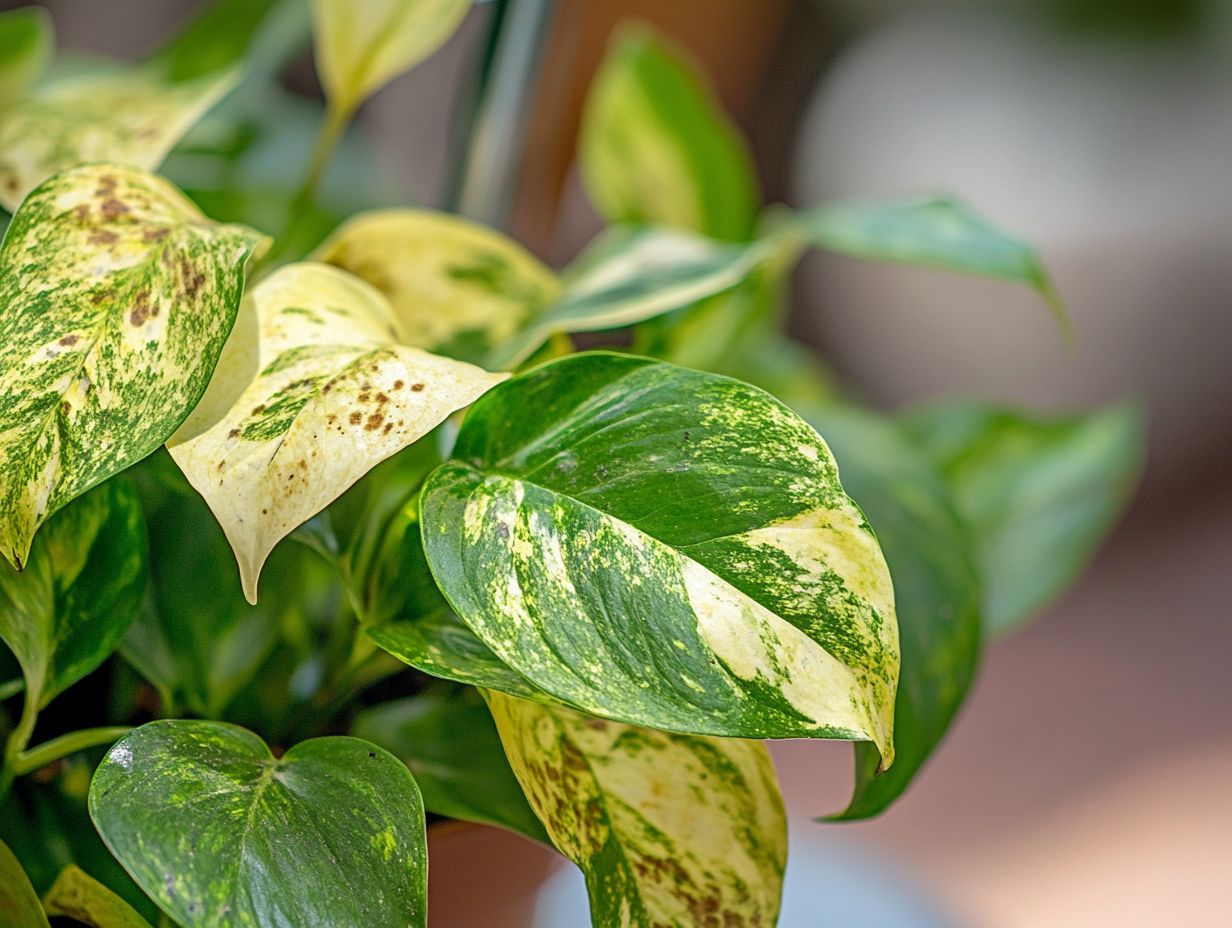
Pothos plants can be vulnerable to pests and diseases that threaten their health. Common pests include spider mites and mealybugs, which may cause noticeable damage to your plant. Root rot can develop from high humidity and poor drainage.
These pests leave clear signs, such as tiny webbing or cotton-like clusters. Fungal infections may also show up as yellowing leaves or dark spots.
To tackle these challenges, adopt strong pest management strategies. Regular inspections are vital. Consider inviting beneficial insects like ladybugs to help. Maintaining optimal humidity levels and ensuring your Pothos gets the right light are essential preventive measures.
Root Rot
Root rot is a serious threat to Pothos plants, primarily caused by overwatering and poor drainage. Overwatering causes moisture levels to rise too high, leading to root decay and jeopardizing the plant’s health. To protect your plant, manage your watering routines and use a well-draining potting mix.
Identify root rot early by watching for symptoms like yellowing leaves, wilting, or a bad smell from the soil. This condition arises from stagnant water around the roots, which fosters fungal growth. Keep a close eye on moisture levels consider using a simple tool like a moisture gauge for accuracy.
If root rot strikes, act quickly! Repot the plant in fresh, sterile soil, ideally using a mix with perlite or orchid bark to improve air circulation. Remember to allow the plant to dry out between waterings to maintain healthy roots.
Identifying and Addressing Issues
Spotting problems in your Pothos is crucial for keeping them healthy. Look for symptoms such as yellowing leaves, curling foliage, or pest signs.
Once you identify the issue, implementing effective solutions is essential.
A strategic approach to plant care will help you revive struggling Pothos and encourage strong growth, turning your plants into flourishing green beauties.
Diagnosing the Problem
Diagnosing issues with your Pothos plants means closely observing key symptoms, like yellowing leaves, curling foliage, and pest signs. By watching these indicators, you can tell if problems stem from overwatering, nutrient issues, or pests, guiding you to corrective measures.
Start by evaluating the light conditions where your Pothos lives; too little or too much light can cause similar symptoms. Next, check the soil’s moisture levels; overwatering can lead to root rot, while underwatering may cause wilting and discoloration. For more detailed information, refer to this guide on how to care for Pothos plants at home.
Inspect the leaves and surrounding areas for any signs of pests, such as webbing or small holes. By evaluating these factors systematically, you can recognize patterns in the symptoms, making it easier to identify the underlying issues affecting your plant’s health.
Effective Solutions
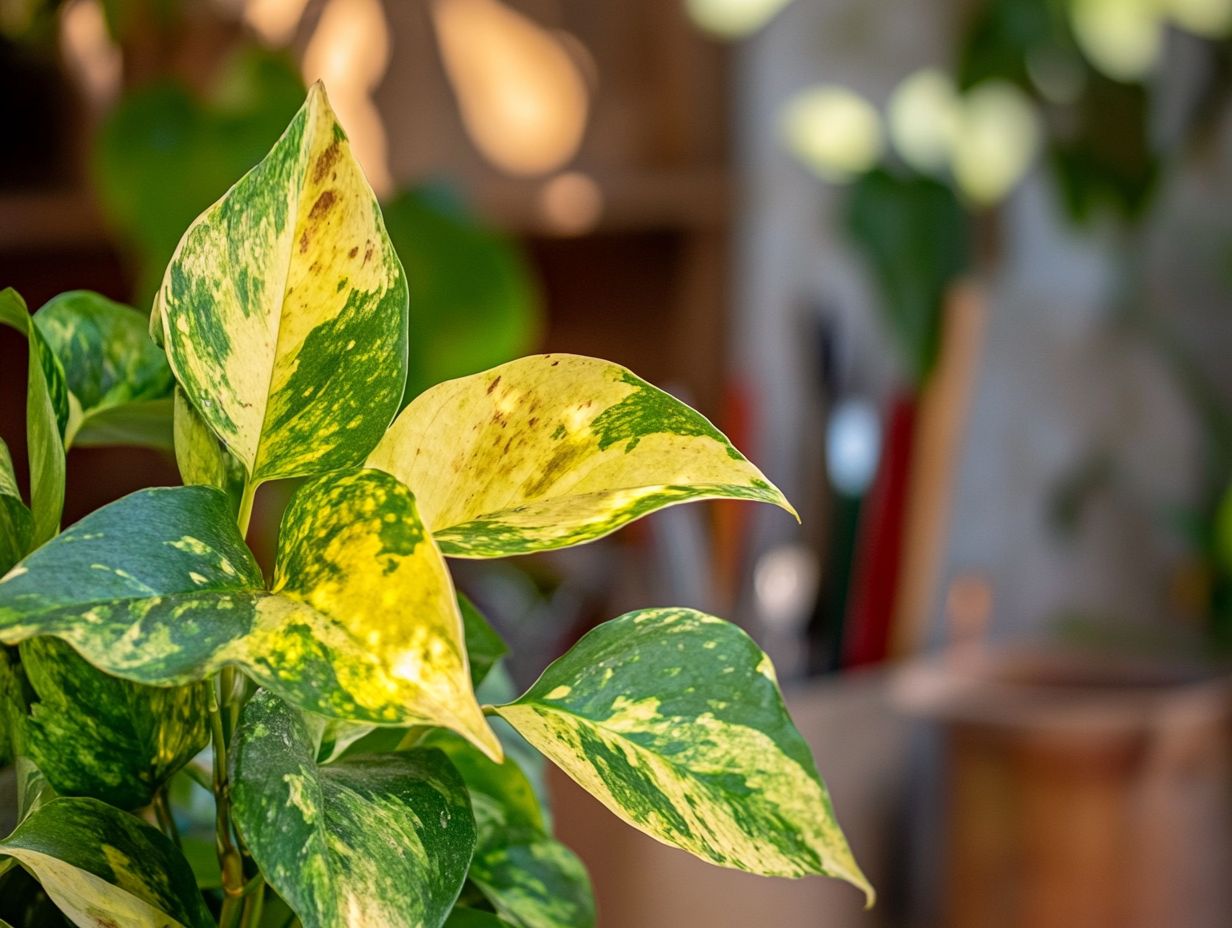
Using effective strategies can truly restore the vitality of your Pothos plants. This ensures they flourish in your indoor gardening oasis. You might consider adjusting your watering habits, opting for a high-quality soil used for planting, and incorporating an appropriate organic fertilizer. These steps will help address nutrient imbalances and foster robust growth.
Think about the role of light placement. Pothos plants thrive in indirect sunlight and can struggle in overly intense conditions. Regularly pruning away yellow or damaged leaves not only enhances the aesthetic but also encourages new growth, resulting in a fuller, healthier plant.
Monitoring humidity levels can significantly benefit these tropical natives. Using a humidifier or misting them occasionally can create an ideal environment. Select a pot with proper drainage to prevent waterlogging and keep the roots healthy and free from rot.
By following these straightforward yet impactful steps, you can cultivate thriving Pothos plants that add beauty and life to your indoor space.
Preventing Future Problems
Preventing future issues with your Pothos plants is crucial for preserving their beauty and vitality in your indoor garden. By embracing straightforward care tips and steering clear of common pitfalls, you can cultivate an environment that fosters healthy growth. This minimizes the likelihood of leaf problems, pest infestations, and diseases.
Grasping these preventive measures is essential for mastering the art of Pothos care.
Care Tips for Healthy Pothos Plants
Using effective care tips can significantly enhance the health of your Pothos plants. This ensures they thrive in a variety of indoor settings. By providing the right amount of indirect sunlight and maintaining appropriate moisture levels, you can foster vibrant growth and help prevent common issues like yellowing leaves and pest infestations.
To achieve this, it s essential to establish a consistent watering schedule. Allow the soil to dry out slightly between sessions typically watering every 1-2 weeks, depending on humidity and temperature. Pothos plants prefer bright, indirect light but are adaptable to lower light conditions. Just keep in mind that they may grow more slowly in such environments.
Paying attention to humidity levels is crucial. These plants thrive in higher humidity. Misting or using a humidity tray can be a game changer during those drier months. Seasonal adjustments are also important. Reduce watering frequency in winter while incorporating regular pruning to encourage fuller growth and a bushier appearance.
Common Mistakes to Avoid
Avoiding common mistakes in Pothos care is essential for ensuring the longevity and health of your beloved plants. Frequent issues such as overwatering, underwatering, nutrient imbalances, and neglecting signs of pest infestations can create significant challenges that undermine your plants’ vitality. By being aware of these pitfalls, you can elevate your indoor gardening experience and foster thriving Pothos.
It’s important to recognize that each of these problems often arises from a lack of attention or understanding of your plant s needs. Overwatering, for instance, can lead to a soggy environment ripe for root rot. Underwatering results in wilting and yellowing leaves. Nutrient imbalances can cause stunted growth or discoloration, often going unnoticed if you re not regularly monitoring your plant.
By keeping a vigilant eye on your Pothos, checking for any early signs of distress, and adjusting your care routine accordingly, you can ensure that your plants continue to flourish and brighten your living spaces.
Frequently Asked Questions

What are common problems with Pothos plants?
Wondering what s going wrong with your Pothos? Common problems include yellowing leaves, root rot, pests, and wilting.
Why are my Pothos plant leaves turning yellow?
Yellowing leaves on Pothos plants can be caused by overwatering, underwatering, insufficient lighting, or nutrient deficiencies.
How can I prevent root rot in my Pothos plant?
To prevent root rot in Pothos plants, ensure the soil drains well. Overwatering is a common mistake, so be mindful of your watering schedule.
What pests commonly affect Pothos plants?
Mealybugs, spider mites, and aphids are the main pests to watch out for. Check your plant regularly and treat any pests to keep it healthy.
What should I do if my Pothos plant is wilting?
Wilting can signal overwatering or underwatering. Check the moisture level in the soil and inspect the roots for any signs of rot.
How can I revive a dying Pothos plant?
Act quickly if your Pothos plant shows signs of dying! Adjust its lighting, watering, and fertilizing conditions, and prune any damaged leaves or roots.

